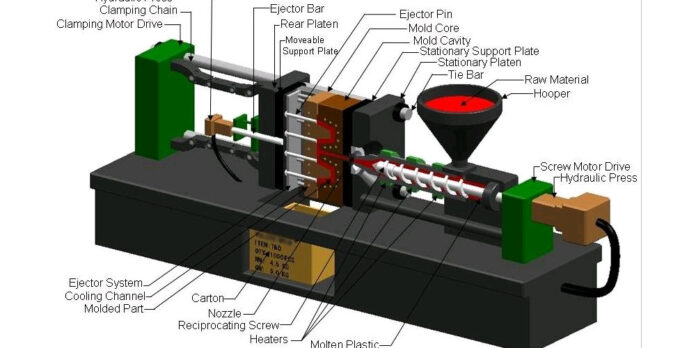Plastic injection molding, also known as injection molding, is formative manufacturing technology. This manufacturing technology is as essential as an additive and subtractive production technologies. This method uses plastic injection mold to give shape to liquid or molten plastics. This mode of manufacturing is currently prevalent. For this reason, there are several mold manufacturers in the industry. These companies operate using plastic injection molding machines. In this post, we discuss the components of these machines.
The anatomy of an injection mold
An injection molding machine is also known as a press. The injection mold usually looks complicated and detailed. However, it is simpler than that. An injection mold machine features the following parts;
- Clam plates- these are the parts on which the mold haves are attached. They use large bolts to hold the molds in place. Some machines use magnets instead of bolts. The typical type of injection molding machine features a two-plate mold design. However, there are a few types of designs that feature three or more plates.
- Feed system- this is a series of parts used to feed the material into the injection molding machine.
- Injection ram or screw-type plunger
- Heating unit- this is the part where the plastic is heated and converted into molten plastic.
- Sprue orifice-this is the part of the machine through which the plastic is injected into the mold. It is a small opening that can accommodate the molten plastic. This part sits on the surface of the mold.
- Feed system- this is the component through which the plastic flows to the sprue, then to the individual runners. It can also be referred to as the gate for the materials to enter into the respective cavities.
- Cavities- these are the molding machine parts where the product is formed into the desired shape. The number of cavities in a device depends on the type of product being manufactured.
- Guide pillars- these parts are used to ensure that the cavities and mold haves are in proper alignment when the mold closes.
- Cooling unit- this is the part where the molten plastic is cooled. The hot molten plastic is passed through cooling channels to cool and assume the desired shape. A working fluid is typically used in this unit. Most of the time, the working fluid is water. However, in some instances, oil is used instead. There is usually an external pump connected to passageways to the mold. The passage allows water to circulate within the parts to remove the heat from the hot plastic.
- Ejector system- these are a series of pins and bars used for pushing a series of pins or bars.
Final word
The parts mentioned above can be broken down into the following simple categories. These are; the gating, molding, ejection, and cooling system. Plastic injection molding is used to produce parts in large volumes. In simpler terms, the technology is applied in mass production. This is the primary benefit of this type of technology. However, there are several other benefits that you may want to look into if you’re going to get into this industry.











